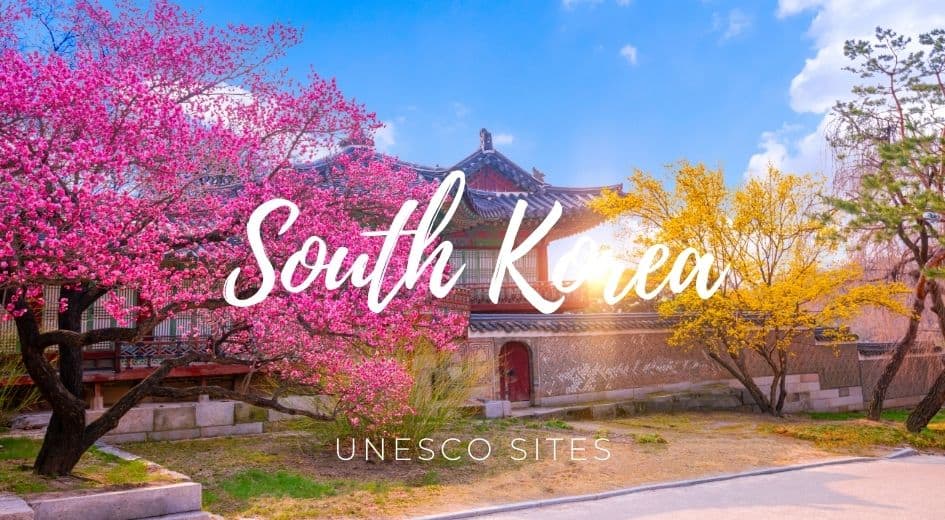Table of Contents


South Korea UNESCO has registered 15 sites on the World Heritage list and 13 on the tentative list.
Some places are so interesting that it’s relevant to keep them for future generations. This is why UNESCO has built a list of crucial classified properties in which superb places stand out for their aesthetic, natural, artistic, or cultural significance.
More than a thousand places are registered as Unesco’s World Heritage worldwide. Due to my interest in visiting World Heritage sites, I compiled the UNESCO list in South Korea and the corresponding map.
South Korea UNESCO list
- Baekje Historic Areas
- Changdeokgung Palace Complex
- Gochang, Hwasun and Ganghwa Dolmen Sites
- Gyeongju Historic Areas
- Haeinsa Temple Janggyeong Panjeon, the Depositories for the Tripitaka Koreana Woodblocks
- Historic Villages of Korea: Hahoe and Yangdong
- Hwaseong Fortress
- Jongmyo Shrine
- Namhansanseong
- Royal Tombs of the Joseon Dynasty
- Sansa, Buddhist Mountain Monasteries in Korea
- Seokguram Grotto and Bulguksa Temple
- Seowon, Korean Neo-Confucian Academies
- Getbol, Korean Tidal Flats
- Jeju Volcanic Island and Lava Tubes
South Korea UNESCO Map
Click on the blue pins to view more relevant information about each World Heritage site in South Korea.
Description
- Baekje Historic Areas is a cultural heritage site located in South Korea. It contains many important cultural artifacts and landmarks related to the history of the Baekje dynasty, which ruled over Korea from 18 BC to 660 AD. The site includes several historic buildings, fortresses, and other cultural sites.
- Changdeokgung Palace Complex is a cultural heritage site located in South Korea. It is a well-preserved example of traditional Korean architecture and contains some important cultural artifacts related to the history of the Joseon dynasty, which ruled over Korea from 1392 to 1910.
- Gochang, Hwasun, and Ganghwa Dolmen Sites is a cultural heritage sites in South Korea. It contains several Dolmen sites and large stone structures used as tombs during the Neolithic period.
- Gyeongju Historic Areas is a cultural heritage site located in South Korea. It contains some important cultural artifacts and landmarks related to the history of the Silla dynasty, which ruled over Korea from 57 BC to 935 AD. The site includes several historic buildings, fortresses, and other cultural sites.
- Haeinsa Temple Janggyeong Panjeon, the Depositories for the Tripitaka Koreana Woodblocks is a cultural heritage site in South Korea. It is a well-preserved example of traditional Korean architecture and contains some important cultural artifacts related to the history of Buddhism in Korea.
- Historic Villages of Korea: Hahoe and Yangdong is a cultural heritage sites in South Korea. It contains many well-preserved traditional Korean villages that date back to the Joseon dynasty.
- Hwaseong Fortress is a cultural heritage site located in South Korea. It is a well-preserved example of traditional Korean fortress architecture built during the Joseon dynasty.
- Jongmyo Shrine is a cultural heritage site located in South Korea. It is a well-preserved example of traditional Korean architecture and contains several important cultural artifacts related to the history of the Joseon dynasty.
- Namhansanseong is a cultural heritage site located in South Korea. It is a well-preserved example of traditional Korean fortress architecture built during the Joseon dynasty.
- Royal Tombs of the Joseon Dynasty is a cultural heritage site in South Korea. It contains many tombs of the Joseon dynasty kings and their families and is a well-preserved example of traditional Korean tomb architecture.
- Sansa, Buddhist Mountain Monasteries in Korea is a cultural heritage site located in South Korea. It contains some well-preserved Buddhist monasteries and temples that date back to the Joseon dynasty.
- Seokguram Grotto and Bulguksa Temple are cultural heritage sites in South Korea. It is a well-preserved example of traditional Korean architecture and contains some important cultural artifacts related to the history of Buddhism in Korea.
- Seowon, Korean Neo-Confucian Academies is a cultural heritage site in South Korea. It contains many well-preserved Confucian academies that date back to the Joseon dynasty.
- Getbol, Korean Tidal Flats is a natural heritage site in South Korea. It contains many important tidal flats that provide important habitats for various species and are an important part of Korea’s cultural and ecological heritage.
- Jeju Volcanic Island and Lava Tubes is a natural heritage site in South Korea. It contains important volcanic features, including craters, lava tubes, volcanic cones, and several unique plant and animal species found only on the island.
UNESCO World Heritage Sites in South Korea have protected places for their cultural and natural importance.
Sites on the Tentative List
- Kangjingun Kiln Sites
- Mt. Soraksan Nature Reserve
- Sites of fossilized dinosaurs throughout the Southern seacoast
- Salterns
- Daegokcheon Stream Petroglyphs
- Ancient Mountain Fortresses in Central Korea
- Upo Wetland
- Naganeupseong, Town Fortress, and Village
- Oeam Village
- Stone Buddhas and Pagodas at Hwasun Unjusa Temple
- Gaya Tumuli
- Archaeological Remains at the Hoeamsa Temple Site in Yangju City
- Capital Fortifications of Hanyang : Hangyangdoseong Capital City Wall, Bukhansanseong Mountain Fortress, and Tangchundaeseong Defense Wall


